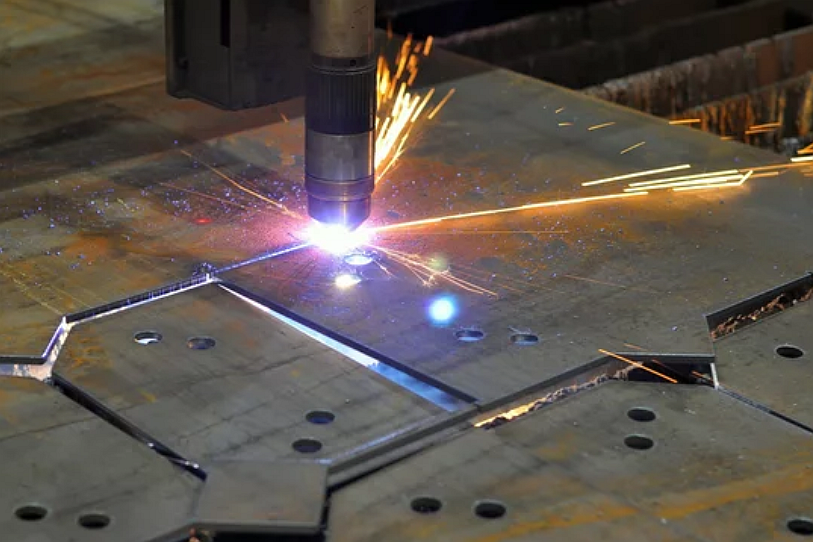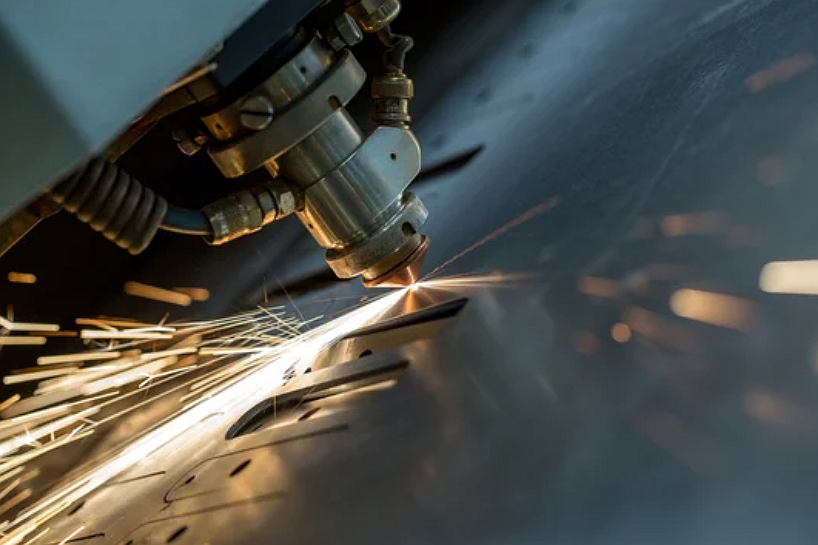The plasma and laser cutting processes are two of the most common thermal cutting processes used in manufacturing and fabrication. Both utilize incredibly high temperatures to melt and cut through metal but use different methods to generate that heat. Understanding the differences between these two processes can help determine which is better suited for a particular application.

How Plasma Cutting Works
Plasma cutting service uses a compressed gas, usually compressed air, to create a very high-temperature plasma arc that melts and cuts through metal. Inside the plasma torch, a spark is generated, which ionizes the compressed gas into plasma. This plasma exits the torch at very high speeds, up to the speed of sound, and at extremely high temperatures, around 20,000°F or higher.
The plasma arc is constricted and focused by a small orifice in the plasma torch nozzle. As the superheated plasma jet contacts the workpiece, it melts the metal into a liquid state which is then blown away by the force of the plasma stream. The plasma torch is moved along the cut path either manually or by a CNC machine, leaving a narrow kerf cut through the total thickness of the metal.
Plasma cutting can cut any electrically conductive metal, including steel, stainless steel, aluminum, brass, Etc. It is an effective process for cutting metal from about 1/8" thickness up to 6" or more thickness. The thickness capabilities depend on the plasma system power level and arc force. More powerful plasma systems with higher amperages can cut thicker material.
Plasma cutting advantages
It can achieve fast cut speeds, over 100 inches per minute, on thinner metals, meaning high productivity.
The narrow kerf width, around 1/16" to 1/8", minimizes the amount of wasted material.
It produces clean, square-cut edges with a smooth surface finish. Minimal secondary finishing is required.
Plasma systems are relatively compact and portable compared to other industrial cutting tools.
It can make bevel cuts at various angles by tilting the plasma torch.
Drawbacks of plasma cutting
More setup and processing variables (amperage, gas pressure, torch height) must be dialed in correctly.
More operator skill is required to produce clean cuts compared to other methods.
The plasma arc kicks up many fumes and smoke that must be adequately ventilated.
It generates much noise, averaging 85-100 decibels. Hearing protection must be worn.
The cost of compressed gas and other consumable parts makes operation more expensive over time.
Plasma cutting is a versatile, high-speed thermal cutting process suitable for most metals. It produces clean, precision cuts when set up correctly.
How Laser Cutting Works
The laser cutting process utilizes a powerful, focused laser beam to melt and vaporize metal into a kerf cut. Light energy is amplified and emitted inside the laser resonator through the laser optics as a coherent, monochromatic laser beam.

The focused laser beam heats the metal workpiece to its melting point, around 3000°F for steel. A high-pressure assist gas, usually compressed oxygen, is blown through the laser nozzle at the same time. The assist gas reacts with the molten metal to rapidly burn and blow away the material into vapor and small particles, leaving a narrow cut line.
Like plasma cutting, the laser cutting head assembly is moved along the cut path by a CNC motion control system or through manual operation. It creates a precise, clean-edge cut through the total thickness of the metal.
Laser cutting is exact, with possible kerf widths as small as 0.005". Cut quality is excellent, producing clean, smooth edges that typically require no secondary finishing.
Laser cutting advantages
Exceptional accuracy and cut quality with a narrow kerf width. Cut lines and contours can be tolerable within +/- 0.005".
No tool contact with the metal means no wear, tear, or drag during cutting.
Minimal heat affected zone or distortion since such a small material zone is heated.
It can cut highly reflective or alloyed metals like aluminum, copper, and brass that are difficult with plasma.
Fiber lasers are very energy efficient, converting up to 35% of input power to beam power.
It has low operation and maintenance costs than other industrial cutting tools.
Limitations of laser cutting
Higher equipment costs are often 4-5x more than equivalent plasma cutters.
Cutting capacity is lower, usually under 1" for most practical applications.
Not practical for thermal barrier materials like wood, plastic, and foam. The laser energy passes through without cutting.
Assistance gas consumption adds operating costs. Nitrogen is often used instead of oxygen as an assist gas to lower costs.
Fume extraction and filtration systems are required to manage smoke/vapors.
Laser cutting achieves unmatched precision and quality on thinner gauge metals like stainless steel, aluminum, and mild steel. It is the go-to thermal cutting process for many manufacturing applications.
Comparison of Plasma & Laser Cutting
Cutting Speed
On thinner metals under 1/4" thick, plasma can cut much faster, over 100 IPM, while lasers are usually limited to under 50 IPM. On thicker metals, the cut speed evens out between the two processes.
Accuracy & Cut Quality The laser beam enables precise cutting with minimal kerf, down to 0.005" in some cases. Plasma has a wider cut and more variance in precision.
Thickness Capabilities Plasma has the advantage of thicker material, able to cut 6" and more excellent. Lasers max out around 1" for practical cutting applications.
Types of Metals
Laser handles shiny, highly conductive metals like aluminum better than plasma. Plasma can be used across more metal types, including painted/coated materials.
Operating Costs Lasers have higher equipment costs but very economical operation and upkeep over time. Plasmas are more affordable up front, but the ongoing costs for gas and parts make them more expensive long term.
Kerf Width & Heat Affected Zone
The laser's narrow kerf and small heat-affected zone produce less wasted material and warping. Plasma cutting has broader kerf and more pronounced heat effects.
Cut Surface Finish
Laser cutting leaves a smoother surface finish that typically needs no additional finishing or clean-up afterward. Plasma requires more post-cutting, grinding, sanding, or milling.
Precision Lasers offer exact cutting tolerances down to 0.005" with no drag or path deviation. Plasma has some inherent cut variance and tolerances of about +/- 0.020".
Production Environments Lasers produce almost no noise pollution and minimal fumes. Plasma generates loud noise levels and ozone that must be controlled.
Automation
Both plasma and lasers are easily automated with CNC controls. Low-maintenance lasers may have an edge for lights-out cutting.
Cut Profile Options Plasma offers good bevel and compound cutting capabilities that lasers cannot match. But lasers can handle much more complex, intricate cut paths.
Summary
Plasma cutting and laser cutting each have advantages that make them suitable for different situations:
Plasma is preferable for thicker metals over 1" and situations where precision is less critical. The high cut speeds and lower costs are advantageous for many general fabrication applications.
Laser excels at precise, clean-edge cutting of thinner gauge material. Unmatched accuracy and smooth cut quality account for ubiquitous lasers in manufacturing industries.
For cutting mild steel under 1/4" thick, either plasma or laser can effectively be applied with good results.
How to Select Cutting Process
When selecting between plasma or laser, considerations include the material thickness, precision required, production volumes, cut quality needs, operating budgets, and types of metal alloys to be cut. Consulting with Neway sheet metal cutting engineer is invaluable to choosing the best process for a given application.
Many fabrication shops combine plasma and laser cutting systems to capitalize on the unique strengths of each. Plasma handles the thicker steel cutting tasks while the laser takes care of anything that requires high precision, intricate contours, or stainless steel and aluminum cutting. This hybrid approach provides the most flexible and cost-effective metal fabrication capabilities.
评论
发表评论